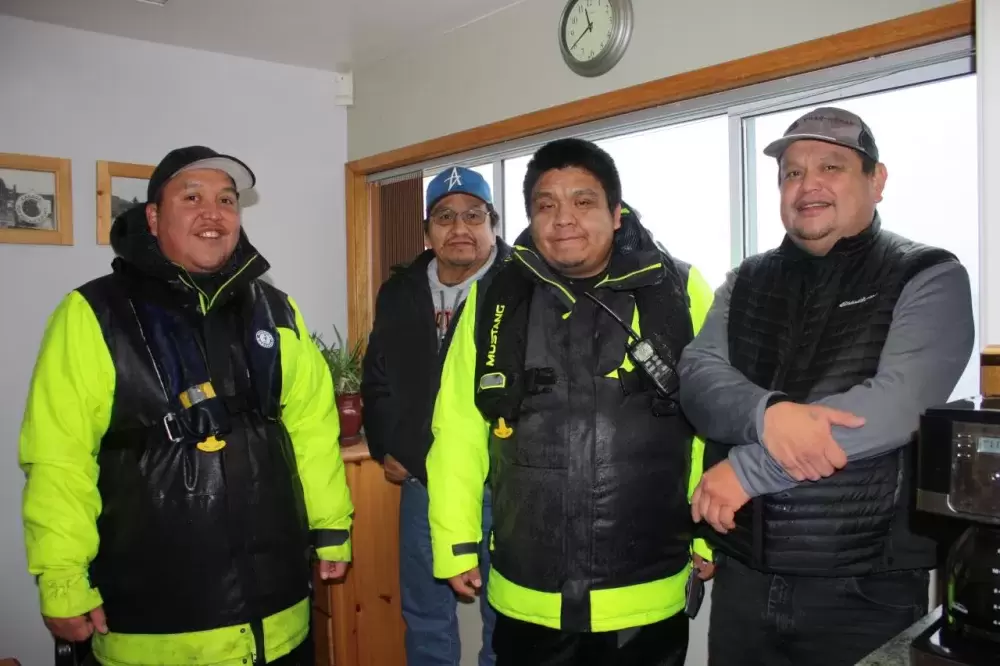Search and Rescue training exercises with the Canadian Coast Guard were conducted in Tofino Jan. 28 and Jan. 29 with participants from Ahousaht and Tla-o-qui-aht. The exercises were in response to calls by the Nuu-chah-nulth nations for more training following the Leviathan II capsizing on Oct. 25 last year.
Ahousaht and Tla-o-qu-aht were the first to respond to a distress signal from the passengers of the Leviathan II, pulling 21 survivors from the waters at Cleland Island, just north of Vargas Island off the west coast of Vancouver Island, and recovering five bodies. A sixth body was recovered 24 days after the accident.
Clay Evans of Canadian Coast Guard Search and Rescue said SAR exercises are held regularly up and down the coast of British Columbia, but the Tofino area has been prioritized following consultations with local first nations.
The training started indoors with round-table discussions about coordination of search and rescue emergencies.
“These efforts with the CCG (Canadian Coast Guard) have been in the works since November, shortly after the Leviathan accident,” said Alec Dick of Ahousaht. “I started receiving emails from Search and Rescue.”
Participants in the training exercise included the Canadian Coast Guard SAR Station Tofino, Canadian Coast Guard SAR Programs, Joint Rescue Coordination Centre (JRCC), MCTS Prince Rupert, RCMSAR Long Beach, RCMP Tofino and Ahousaht First Nation, Tla-o-qui-aht First Nation, Parks Canada, and West Coast Inland Search and Rescue.
Nuu-chah-nulth participants were Alec Dick, Greg Charlie, Greg Hayes, Andrew Jackson, and Michael Swan.
Day one of the exercise allowed the participants the opportunity to learn how the Canadian Coast Guard and other emergency responders operate in a SAR emergency. They learned the theory, procedures and myriad of terms and acronyms used when communicating with one another during a SAR operation.
They also did the prep work that would guide them through their SAR training exercise the following day.
“It’s all about coordination and communication,” said Geoff Denman of the JRCC, located in Victoria. Denman was in Tofino to assist with the exercise.
The purpose of the exercise was to demonstrate the ability to have effective communications and interoperability between all of the vessels participating in the SAR exercise.
The exercise itself started shortly after 9 a.m. on Jan. 29 with an urgent marine broadcast issued by MCTS Prince Rupert. It was raining heavily and the sea was rough.
The searchers would look for two tandem kayaks with four persons missing around Vargas Island. The search area included the Tofino shoreline and all areas in and around Vargas Island.
After receiving a 911 call, the JRCC in Victoria alerts the Coast Guard Station in Tofino triggering the crew of the vessel CCGS MLB Cape Ann to begin the search. Other vessels joining the search communicate with one another via VHF radio or cell phone. They take direction from personnel aboard the Cape Ann on where to search.
The missing kayakers (actors in the exercise) were eventually located in two separate areas on Vargas Island. The searchers were called in to the Tofino Coast Guard Station for a headcount and debriefing.
Denman said the Coast Guard does these types of exercises about once a year. It’s about getting to know one another and improving communications, because, at the end of the day, it’s good to know who is on the other end of the radio,” he said.
“It’s good, positive to work together rather than be on separate sides,” said Dick, adding that there is a need to hone in on communications.
Denman said the exercise went well with good communication and a happy ending.
Alec Dick agreed, saying this is something they need to do more of – to expand their resources.
The coordination effort allowed the searchers to cover a large search grid in a relatively short period of time.
One of the issues discovered during the search was a place name known locally as MacIntosh Island, where two of the missing kayakers were found. One of the searchers didn’t know where that was and it was not on his chart plotter.
Communication problems and local place names that were not recognized by MCTS Prince Rupert became an issue during the rescue of the passengers of the Leviathan II.
Following that accident, the fishermen first on scene, Clarence Smith and Ken Brown, described the difficulty they encountered in their attempts to call for help. Following several attempts to communicate with the Coast Guard, fishermen tied up in Tofino ended up relaying the distress call.
Fisherman Rob Barton eventually broke into the radio communication and reported what Smith was saying to the Coast Guard, before boarding a speedboat to head to the accident.
Smith managed to contact Ahousaht Emergency Response Team Coordinator Alec Dick who sent rescue boats from Ahousaht to respond. He used the local place name Bare Island, not Cleland Island.
Denman said exercises like the one held in January help to improve communications with what the Coast Guard calls VOOs (Vessels of Opportunity), like water taxis, tour boats and fishermen.
“The passion and effort in the communities is evident and I hope there’s more training exercises like this,” he said.
Clay Evans said further SAR training for first nations in Clayoquot Sound will be offered soon. Space is limited and training will be intense, so the CCG is asking that nations submit the name of one suitable candidate each.
The training will take in Bamfield from March 10 to March 15. The same training has taken place in first nations communities further north and, according to Evans, it has been well received.







